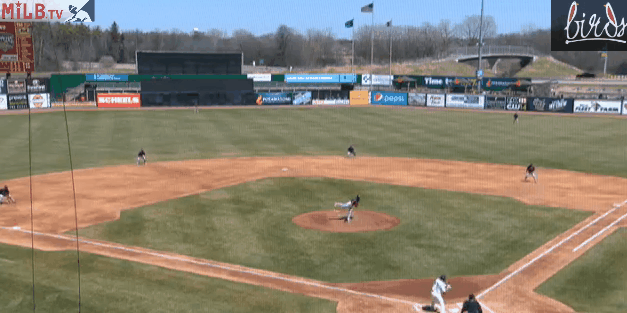
In the year 2000, one Albert Pujols played 109 games as a Peoria Chief. In his first year at the full-season level, the baseball world was treated to an eye-opening glimpse at what the 13th rounder could become.
Pujols carried a .953 OPS over the course of the season, notching 128 hits (which included 32 doubles, 6 triples, and 17 home runs), while driving in 84 runs, walking 38 times, and striking out 37 times in 395 at bats.
The next year, he played 161 games in St. Louis.
In the year 2018, one Elehuris Montero became the first Peoria Chiefs player since Pujols to be named — on his 20th birthday — the Midwest League MVP.
A relative unknown coming in to the season, Montero made quick work of changing that narrative. In 103 games at Class A Peoria, he slashed .322/.381/.529, spraying 123 hits to all fields, including 28 doubles and 15 home runs.
But the numbers — impressive as they may be — are merely the foreword to the story the teenager’s work wrote this season.
“Very quiet, very soft spoken, but very observant and paying attention to details,” Peoria Chiefs Manager Chris Swauger said of Montero. “Even though he wasn’t saying a lot, you could see the wheels turning in his head, and then you could see it by the adjustments he would make at bat to at bat, and even pitch to pitch.”
That ability to adjust was the first indication to the Peoria staff that Montero was a hidden gem. In a world where information and data abounds, the knack for translating and applying the material is as valuable an asset as quick hands or measured steps.
“Everybody’s given the same information about their strengths, about their weaknesses, about what they should do, what type of player they should be,” Swauger said. “But not everybody can take it and then apply it. Some can, but it takes a little bit of time. With Elehuris, it was almost like an immediate processing and application in the game.”
While big picture ideas like exit velocity and launch angle are popular in this chapter of baseball’s story, it was all about the details for Montero. Even when his other tools combined to rank him low on prospect lists, his hit tool kept him in the conversation. But even that was raw, and underdeveloped. Swauger’s staff combed through the data and found in the details a clear path to improvement for the promising young hitter:
Keep hammering fastballs, but learn to pass on breaking balls outside the zone. Breaking balls up, and in or just above the zone — those would be the pitches Montero must learn to hit in order to compensate for opposing pitchers abandoning their hittable fastballs against him.
“I think he really, really grasped that and took ahold of that and kind of owned it a little bit to where you could see really significant improvement on just how he took pitches and how he went about at bats and paid attention to what pitchers were trying to do to him,” Swauger said. “Consequently, he found himself in better counts and was then getting better pitches to hit.”

Perhaps no one had a better view of Montero’s development than Director of Media & Baseball Operations and voice of the Peoria Chiefs, Nathan Baliva, who watched day in and day out as Montero’s story became impossible to ignore.
“To me the biggest thing with him was his consistency — especially as a kid that was 19 the entire time he was here — to have consistent at bats never give away an at bat,” Baliva said. “He always had hard contact and really played like a college guy and not like a 19-year-old who is just in his second year of pro ball in the United States.”
Consistent, but ever-changing. A balance rarely found in one so young.
“Nearly everyone of his rates and counting stats showed improvement from month to month,” resident prospect expert Kyle Reis said. “K-rate? He lowered it from month to month. BB-rate? He raised it from month to month. His hard hit rate? Well, the theme continues. Montero made gains in every category in a league that was too advanced for his age by 2.3 years on average.”
And lest you think Montero might become content to rely on his proficiency at the plate alone, Swauger volunteered plenty of examples of improvement in the defensive chapter of the Elehuris Montero story, too.
“He’s had good hands, he has a good arm, but he could never link the two up,” Swauger said. “So, his general rhythm with fielding ground balls and playing third base, and his positioning and what he needs to do as far as timing of contact and then where he needed to move and how he needed to move to let his well-above-average arm show off… that was a big adjustment for him.”
But similarly, an adjustment that began with data and ended with tangible results. Montero was charged with 14 fielding errors in the 63 games ahead of the Midwest League All-Star break. He had just six errors in the 40 games that followed, ahead of his promotion to High-A Palm Beach.

“His ability to process the information and learn and get better is far beyond a lot of guys we’ve seen at this level, so it makes you really optimistic about what he can do defensively,” Swauger said, and later added, “It was fun to coach a guy like that because there was no limit to the amount of information you could give him.”
And perhaps, no limit to the success story he can become.
Undoubtedly, the Albert Pujols symmetry creates an unfair comparison for the 20 year old. But, as Natasha Bedingfield once said, "Today is where your book begins...The rest is still unwritten."

